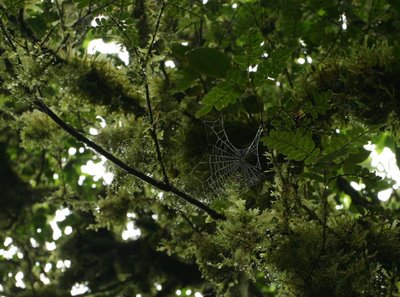Conservation Economics
Monteverde's cloud forest is truly sublime with its distinctive dripping moss. The area has become one of Costa Rica's most famous destinations for ecotourism. In ironic support of that purpose, it's extremely hard to get to: the dirt road is long and jaw-crushingly filled with pot-holes. By this "neglect", the town of St. Elena and the Monteverde Reserve are discouraging day trippers from San Jose. You have to want it; you must commit. And if you do you'll spend more money and speak more favorably of it to your (wealthy) friends.
Founded by Quakers from the US in 1951, early ideas about ecotourism and its ability to make the economics case for conservation were developed here. Unlike most of Costa Rica's protected areas, the Monteverde Reserve itself is privately owned. In order to protect both the forest and visitors' experience of it, the Reserve limits visitors to 120 at a time into this 10,500 hectare property. The price of admission is $12, steep compared to most protected areas, but my sense is that travelers, especially Americans and Europeans, would pay more.
But should Costa Rica convert its economy to ecotourism? It's not an easy argument. Much of Costa Rica may not be interesting to tourists. Small rural communities, pastures, farms: these are not the places tourists flock to. Moreover, compared to agriculture or ranching, tourism is ephemeral. An international economic crisis renders a tourist economy vulnerable whereas the need for cows, banana, pineapple, rice and sugar cane remain.
Over the course of this trip, the irony of Costa Rica has become clear to me. Hailed as a model country for ecotourism, deforestation continues. Celebrated for its visionary park system, most of the parks are inadequately staffed and aren't valued by their surrounding communities. Traveling this landscape, dominated not by forest but by pasture and farms , it's hard not to see that assigning existence value to primary forest is a luxury of the wealthy. Since most of Costa Rica is accessible, even if by crappy roads, every parcel of forest that does remain must justify itself economically to those that own it, manage it and live on or around it. We're closer to the situation in which every tree persists because someone decided it makes some economic sense for it to do so versus a belief in its value as habitat (for monkeys, ants or birds) or its inherent tree-ness.
We spoke with some folks with Fundacorps, a sustainable forestry initiative sponsored in part by World Wildlife Fund, while at La Selva. From those discussions, it became clear that Costa Rica's carbon credit system isn't financially competitive with most other land uses. Furthermore, it's possible to log a forest and then invoke the carbon credit system for several years, then, when you're ready to harvest more trees, turn it off again. That may work well for sequestering carbon, but it doesn't incent the preservation of primary forest and all the biodiversity therein.
At as for the value of biodiversity itself, Merck Pharmaceuticals invested heavily in the protection of biodiversity in Costa Rica to enable "bioprospecting": the mining the forest for tomorrow's chemical compounds. As a consequence, INBio, Costa Rica's national biodiversity institute, was funded to inventory the nation's biodiversity. But Merck's investment didn't pay off. Productivity from synthetics research in the lab outstripped that of the primary forest. Merck has withdrawn most of its funding and INBio now struggles to stay viable.
For those who do see value in the forest's existence, the task is clear: find real economic value that actually pays the bills. That may be ecotourism, carbon sequestration or more abstractly insurance against catastrophe (similar to a diversified financial portfolio, a diverse species portfolio increases nature's chances of recovering from or avoiding disaster). But the value must be real and turn into hard currency for those who have the fate of conserved lands in their hands: local communities, local governments.
Labels: Ecoinformatics, Healthy Planet




0 Comments:
Post a Comment Hide comments